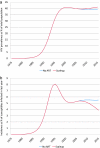Modelling HIV epidemics in the antiretroviral era: the UNAIDS Estimation and Projection package 2009
- PMID: 20929855
- PMCID: PMC3173807
- DOI: 10.1136/sti.2010.044784
Modelling HIV epidemics in the antiretroviral era: the UNAIDS Estimation and Projection package 2009
Abstract
Objective: The UNAIDS Estimation and Projection Package (EPP) is a tool for country-level estimation and short-term projection of HIV/AIDS epidemics based on fitting observed HIV surveillance data on prevalence. This paper describes the adaptations made in EPP 2009, the latest version of this tool, as new issues have arisen in the global response, in particular the global expansion of antiretroviral therapy (ART).
Results: By December 2008 over 4 million people globally were receiving ART, substantially improving their survival. EPP 2009 required modifications to correctly adjust for the effects of ART on incidence and the resulting increases in HIV prevalence in populations with high ART coverage. Because changing incidence is a better indicator of program impact, the 2009 series of UNAIDS tools also focuses on calculating incidence alongside prevalence. Other changes made in EPP 2009 include: an improved procedure, incremental mixture importance sampling, for efficiently generating more accurate uncertainty estimates; provisions to vary the urban/rural population ratios in generalised epidemics over time; introduction of a modified epidemic model that accommodates behaviour change in low incidence settings; and improved procedures for calibrating models. This paper describes these changes in detail, and discusses anticipated future changes in the next version of EPP.
Conflict of interest statement
Figures







References
-
- WHO Treating 3 million by 2005: Making it happen: the WHO strategy. Geneva: World Health Organization, 2003
-
- WHO UNAIDS and UNICEF Towards Universal Access: Scaling up priority HIV/AIDS interventions in the health sector: Progress Report 2009. Geneva: WHO, 2009
-
- UNAIDS Reference Group on Estimates, Modelling and Projections Improved methods and assumptions for estimation of the HIV/AIDS epidemic and its impact: Recommendations of the UNAIDS Reference Group on Estimates, Modelling and Projections. AIDS 2002;16:W1–14 - PubMed
Publication types
MeSH terms
Substances
Grants and funding
LinkOut - more resources
Full Text Sources
Medical
